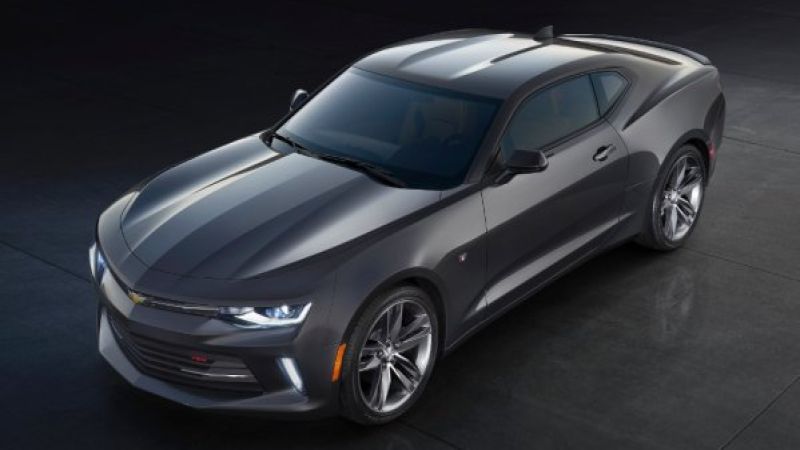When the 2015 Ford Mustang was introduced with the 2.3L EcoBoost engine, the rest of the performance car world was quick to poke fun at the idea of a 4-cylinder muscle car. The Camaro crowd was particularly harsh, but with 310 horsepower and 320lb-ft of torque, the EcoBoost Mustang is still a very solid performance car. When combined with the strong fuel economy ratings, the EcoBoost engine quickly became a popular option with those buyers who wanted a mix of efficiency and performance. In fact, the EcoBoost has grown to be so popular that the most recent sales statement from Ford points out that the 2.3L EcoBoost engine is the bestselling option in the current Mustang lineup in some very large markets.
Based on the popularity of the EcoBoost Mustang, I fully expected to see a turbocharged 4-cylinder 2016 Camaro, especially when considering the fact that the Camaro is based on a similar chassis platform to the Cadillac ATS coupe which also features a stout turbocharged 4-cylinder. However, when the new 2016 Camaro specs were announced, with a turbocharged 4 that only offers 275hp and 295lb-ft of torque, I was shocked that GM hadn’t lifted the output of the 2.0L turbo 4 to better compete with the EcoBoost Mustang.
The Turbocharged 2016 Camaro
Now, before getting further into this, I want to clarify my views on the 2016 Chevrolet Camaro with the turbocharged 2.0L 4-cylinder engine. I think that it is going to sell fairly well in the North American market, where those folks who want the style of the new Camaro with the best fuel economy possible will gladly buy up this new engine option. GM has promised that it will be the most efficient option for 2016 so for those folks who are least worried about performance – this new turbocharged 4-cylinder mill will be an easy choice.
However, the 2015 Ford Mustang EcoBoost has broader appeal, attracting both the buyers who want style and fuel economy as well as those who do care about performance. Not only does the EcoBoost Mustang has a significant power advantage over the turbo Camaro, but it has proven to be a very capable performance engine with very minor upgrades. Of course, the same could very well be true of the Camaro with the turbocharged 4-cylinder, but the Camaro is entering the battle with a disadvantage of 35 horsepower and 25lb-ft of torque. This presents a marketing challenge for GM, as they try to attract those buyers who aren’t set on one car or the other in shopping for a pony car with a good mix of fuel economy and performance. If nothing else, Ford has a very clear advertising edge, boasting more than 300hp while the Camaro does not…and that is the kind of thing that matters to John Q Carbuyer.
This relatively slight difference in power could cause the Camaro’s turbocharged 4 to struggle in the US while the EcoBoost Mustang flourishes, but I think that deep down, GM isn’t really concerned about US sales of the turbo Camaro. The V6 Camaro offers a very comparable level of performance and fuel economy to the EcoBoost so while non-V8 Mustang buyers have flocked to the EcoBoost, non-V8 Camaro buyers in the US are likely to continue leaning towards the V6.
The Turbo 4 Camaro Matters Overseas
While the 2.0L turbo Camaro might struggle to compete with the EcoBoost Mustang on US soil, I believe that the far more important battle will be waged outside of North America. The Camaro has long been available around the world, but only with the V8 engine option and that means that in other parts of the world, the Camaro of the past few years was very expensive to buy and very expensive to feed. GM has not offered the V6 overseas, so there has been no real alternative to allow foreign Camaro fans a more cost effective option when muscle car shopping.
On the other hand, when the 2015 Ford Mustang was introduced on a global level, it was instantly clear that they planned to offer both the Mustang GT and the Mustang EcoBoost all over the world. Like the previous generation Camaro, the Mustang GT will face high prices and big fuel expenses while the 2.3L EcoBoost comes with a lower price tag, fewer penalties for poor fuel economy and less cost in keep it fueled up. That gives Ford a major advantage in the global muscle car war and that is where the turbo 4 Camaro comes into play.
I expect that the 2.0L turbo engine in the 2016 Camaro will be most popular in those markets where gas prices are much higher and where the 3.6L V6 is not offered. Those folks who have wanted to buy a Camaro in Europe or Asia in the past, but who were turned off by the high prices involved with the V8 engine will now have an affordable, efficient engine option that will better suit their needs – just like the EcoBoost has done for the Mustang abroad.
So, while the EcoBoost Mustang continues to grow in popularity over the V6 base model in the US, I expect the V6 Camaro to continue to be the most popular option while European and Chinese buyers will almost certainly line up for the fuel sipping turbo 4 Camaro.












Comments
Didn't you read the press
Permalink
Didn't you read the press release that said that the V6 Camaro is supposed to compete with the Ecoboost Mustang? Your whole article assumes turbo vs turbo and V6 vs V6. Any informed gearhead will know better than that.
Ah, beat me to it. Yeah it's
Permalink
In reply to Didn't you read the press by JohnQPublic (not verified)
Ah, beat me to it. Yeah it's like the author didn't bother to even read the press release, let alone do any actual research. Writers these days . . .
Its not supposed to compete
Permalink
Its not supposed to compete with the Ecoboost. Read the press release. Your premise is faulty.
Seems like the author didn't
Permalink
Seems like the author didn't bother to read into the lineup differences at all. The EcoBoost Mustang will be competing against the v6 Camaro. Chevy opted for the 4<6<8 lineup.
Even if the 2.0t camaro is
Permalink
Even if the 2.0t camaro is down on power it doesn't mean its any slower or less fun to drive. Theoretically speaking and according to Chevy. The camaro could end up being significantly lighter than the mustang. 150-200 lbs possibly. Comparing turbo 4's anyway. After all the turbo 4 ats is just as fast as the ecoboost mustang, and the chassis is best in its class. Beings the camaro is more of a performance oriented car over the luxury sport sedan/coupe ats I'm expecting best specs from the camaro.
Yep....And the 310 hp / 320
Permalink
In reply to Even if the 2.0t camaro is by Tony1991 (not verified)
Yep....And the 310 hp / 320 lb ft. tq for the ecoboost are based on using 93 octane. I've read that there is up to a 15% decrease in power if lower octane gas is used. I think the hp / tq numbers for the Camaro turbo are based on using 91 octane (?).
As others have already said,
Permalink
As others have already said, the Camaro's turbo 4 is the entry level model while the V6 is Mustang's entry level. Ford does not want to sell a V6. They want to push customers into the higher priced ecoboost. You can't get any upgrades on a V6 Mustang. You can't even get satellite radio on a V6 Mustang. You have to buy an ecoboost premium to even get the radio.
GM has an 8-speed auto that will blow the Mustang's old 6-speed out of the water. I'm willing to bet that the Camaro with the 4-banger and 8-speed auto will keep up with the Stang's ecoboost or even beat it. And I'm sure the 4 cyl will get more power over time.
I have had both ecoboost and
Permalink
In reply to As others have already said, by Dogula (not verified)
I have had both ecoboost and now Turbo Camaro. The base model has power seats(both), 8 speed auto and is NO slouch for sure. Best trip mileage 39.9 mpg!
It reminds me of 2010 when
Permalink
It reminds me of 2010 when the v-6 Mustang had 210 hp vs the Gen 5 Camaro coming out with 304. I thing GM will tweak the 2.0 Turbo to match the Mustang as the Mustang eventually did, one year later in 2011 it was making 305. Both v-6's made more than the base classic 327 with just 300.
Camaro knows that those who
Permalink
Camaro knows that those who opt for the 4 cyl will be secretaries, thos wanting the 6 will be happy with good performance and the V8 buyers will want the max power for minimum $$.
Boy, that "secretaries" car
Permalink
In reply to Camaro knows that those who by Rallph Malph (not verified)
Boy, that "secretaries" car statement is pretty asinine..Are you comparing motors like the old Iron Duke 4 banger to the turbo charged engines in the Camaro and Mustang ??
The majority of Camaro and Mustang turbo 4 customers will be into modding their cars. Ford Racing will be offering a tuning option (covered by the warranty) very soon on the Ecoboost.
Rallph Malph - These cars
Permalink
Rallph Malph - These cars have never been secretary cars, especially since the new V6's have come along with 300 hp. The turbo 4 cylinder has more power than some of the previous v8's. Btw, the whole secretary comment is pretty juvenile in the more serious car community.
Ford NEUTERED the V6 HP in
Permalink
Ford NEUTERED the V6 HP in order to elevate their ecoboost, they even devalued the V6 HP a bit in order for it not to compete with the ecoboost. As a matter of fact, I was expecting Ford to add Direct Injection to the V6, which the Camaro V6 has, but they did not. Additionally they removed the availability of the Track Pack from the V6. But still, the V6 Mustang can hold its own.
The automatic Camaro turbo is listed by GM at 3339 lbs, a 0-60 of 5.4 and a 1/4 mi of 14.0 at 99, .85g’s. Just FYI a heavier 2015 Caddy ATS coupe tested by CD, which the Camaro shares the chassis/engine/trannys, at 3,479 lbs with the turbo 4 pulled 0-60 5.7, ¼ mi at 14.1@101.
CD also tested a 2015 Ford Mustang V6 auto, and, at 3,588 lbs it had the following perf stats: 0-60 5.5, ¼ mil 14.0@102, .86g’s which is very close to the ecoboost numbers as well.
So the turbo 4 Camaro auto is lighter than the V6 Mustang auto by 200 lbs. The V6 Mustang auto weighs 6 lbs more than the Turbo Mustang, as per Ford. The real killer of all this is the V6 Camaro auto, which will rip all of the above, manual or auto.
You should be able to get good discounts on the 2015/2016 Mustang V6. The Camaro will sell closer to list since it is a new model. The advantage of the Turbo 4 Camaro over the V6 Mustang is that it's easier to upgrade performance, just by reprogramming the chip for a higher boost/hp.
So, at what octane does the 4
Permalink
So, at what octane does the 4 Camaro actually get 275 hp?
I bought ecoboost 2015 ...
Permalink
I bought ecoboost 2015 ... That was a big mistake. 2015 model has many problems ... I'm selling it before its to late , My next car will be 2016 ecoboost(engine problems solved) or camaro 2.0 .